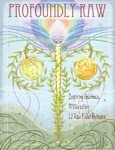Quite a few people have been asking me about B12 recently, so I thought I’d share some of my thoughts on the matter here...
What about vitamin B12?
B12 deficiency tends to be a big health concern among vegan raw fooders. This vitamin is essential for red blood cell formation, energy and nerve function. It seems to be found in western food sources  primarily in meat and dairy produce, so vegans often have low levels of it. (Though many studies also seem to show widespread B12 issues, regardless of whether people eat animal products or not...)
primarily in meat and dairy produce, so vegans often have low levels of it. (Though many studies also seem to show widespread B12 issues, regardless of whether people eat animal products or not...)
B12 Deficiency can lead to exhaustion, dizziness and blackouts. Other symptoms of B12 deficiency include anxiety, pale skin, blurred vision, poor memory, constipation and in severe cases, anaemia and nerve damage. It’s a controversial issue and some suggest there are in fact no reliable vegan sources of B12.
As for me, I feel like I do now get some B12 from the foods I eat - (algaes, seaweeds etc) PLUS I rarely wash my fruit and veg - I like having some soil/micro-organisms in there to help my system produce B12 and thrive ;) I also take good care of my colon, through both consuming probiotics and doing colon cleansing, which means my internal flora produce B12 for me too. To be certain I’m getting all that I need, I also take a B12 supplement regularly, which I feel is like my ‘ back up’ in case the foods and internal flora really aren’t working.
back up’ in case the foods and internal flora really aren’t working.
A couple of years into my raw journey, I actually experienced a serious B12 deficiency. At that time, my food intake was quite unbalanced, I was doing no colon cleansing and taking no B12 supplement. I was pale, dizzy and low in energy and ended up having blood tests to determine the cause, after a fainting spell. After discovering I had a low B12 count, I started taking supplements and my health improved rapidly...
I hope that gives some answers for any enquiring minds out there...also read on below for an easy, cheap way to help support your ‘friendly’ intestinal flora to rustle up their own B12 ;)
on March the 12th I had:
1 quart water
mug of pau d’arco tea
2 cups greeeeeen juice: celery, cucumber, landcress, parsley, Jerusalem artichoke, endive, fennel, ginger
2 cups energy soup with okra and tahini on the side
mug of spicy tea
3 cups water
2 cups green juice: celery, cucumber, landcress, parsley, Jerusalem artichoke, endive, fennel, ginger
3 cups hemp milk with cardamom/cinnamon/vanillaaaaaaaa :)
2 cups green juice
2 cups water
I was recently sent a link to a great article by the lovely Lenette Nakauchi in Chicago, on ‘22 Ways to Save Money’ as a raw foodist.
I love the number 22 and I loved this cool article too, packed with useful suggestions – check it out HERE for sweet little tips on buying in bulk, foraging, sprouting...aaaaaaand making your own fermented yummies – more on that below... ;)
on March the 13th I had:
1 quart water
mug of pau d’arco tea
2 cups green juice: celery, cucumber, landcress, parsley, Jerusalem artichoke, endive, fennel, ginger
2 cups energy soup with okra and tahini on the side
mug of spicy tea
3 cups water
2 cups green juice: celery, cucumber, landcress, parsley, Jerusalem artichoke, endive, fennel, ginger
an apple, sea spaghetti salad with Ms. Magic, followed by spicy tea and yummmmmmy ‘cool happy cakes’ ;)
2 cups water
You asked, we delivered ;) There have been numerous requests lately too for a video showing how to make Rejuvelac...so, I got my filming/editing hat out and put the following together:

:) Hope that helps for any budding fermenters out there ;) I’ve been making rejuvelac consistently for the last few weeks now here in the UK, using it as the base for all my energy soups... It’s a great, inexpensive way to get live enzymes and probiotics into your body tooooooo...
Here’s a 7–Day Rejuvelac Timeline for your delectation:
Day 1: Leave wheatberries to soak in water overnight.
Day 2: Morning - discard soak water, leave wheat to sprout. Evening - rinse sprouts with clean water.
Day 3: Morning and evening - rinse sprouts off with clean water.
Day 4: Place sprouted wheat into a container and cover with lots of water to create the rejuvelac. Leave to ferment for the next 36-48 hours or so.
Day 5: Leave the rejuvelac fermenting.
Day 6: Decant the drink into containers, into the fridge. Add more water onto the wheat to make a second batch of rejuvelac.
Day 7: Decant the second batch of rejuvelac and offer the wheatberries to the local birdies ;)
ENJOY :)
All delight and joy to you...
Ms. Stokes. xxx










